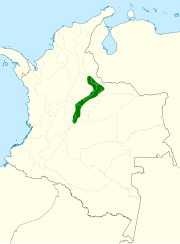|
Bearded helmetcrest
The bearded helmetcrests (Oxypogon) are a genus of hummingbird in the family Trochilidae. They are found in Colombia and Venezuela. Primary natural habitat is subtropical or tropical high-altitude grassland, known as páramo. The genus contains four species. Taxonomy and species listThe genus Oxypogon was introduced in 1848 by the English ornithologist John Gould.[1] The type species was subsequently designated as the green-bearded helmetcrest.[2][3] The genus name combines the Ancient Greek oxus meaning "sharp" or "pointed" with pōgōn meaning "beard".[4] The genus contains four species:[5]
These four species were formerly all considered as subspecies of what was known as the bearded helmetcrest (Oxypogon guerinii). The bearded helmetcrest was split into four separate species based on a study of biometric and plumage data published in 2013.[5][6] A study of mitochondrial DNA of hummingbirds shows it to be most closely related to the bearded mountaineer (Oreonympha nobilis) and the rufous-capped thornbill (Chalcostigma ruficeps). The other member of the genus Chalcostigma lay outside the group, suggesting the genus might need revising in the future.[7] DescriptionThe most common species, the white-bearded helmetcrest, measures 11.4 cm (4.5 in) in length, it is a small hummingbird with a very small 8 mm (0.31 in) bill. The adult male has a distinctive pointed black crest and a shaggy white beard. The face and cheeks are blackish, rendering a triangular shape with the white fronted crest and white beard. The underparts are a dull green-grey. The female lacks the beard and crest.[8][9] The species of bearded helmetcrests are found in the Andes, ranging from altitudes of 3,600 to 4,500 m (11,800 to 14,800 ft) in Venezuela,[9] and 3,200 to 5,200 m (10,500 to 17,100 ft) in Colombia.[8] Its main habitat is the páramo, but can descend to the treeline outside of breeding season.[9] All species often perch on boulders and flit between low-flowering shrubs, visiting the flowers of the genera Espeletia, Echeveria, Siphocampylus, Castilleja and Draba.[9] All species breed during the rainy season, and nest in the daisy Espeletia or build a nest of material from the daisy in a cliff or bank.[9] References
|
|||||||||||||||||||||||||||||||||||||||||||||||||||||||||||















